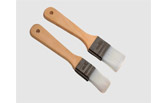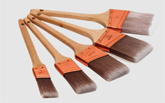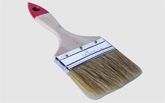How to Choose the Right Brush?
Jul. 07, 2021In your local home center, paint shop or hardware store, faced with a
dazzling array of paint brushes, choosing the right paint brush can be
overwhelming. But don’t worry! Here is how the Painting Tools Manufacturer can
reduce the range of different types of brushes and choose the right brush for
your project.
Match the type of bristles to your finish.
Paint brushes have synthetic bristles or natural bristles made from animal hair. If you are using a paint or varnish that can be washed with water, choose a brush with synthetic bristles. If you are applying oily varnish or paint, a brush with natural bristles (black porcelain, cow hair blend or white porcelain) may be a better choice. You can use synthetic bristles for oil-based paint, but in most cases, natural bristles will provide a smoother finish. However, avoid using natural bristle brushes to apply water-based finishes. The bristles will absorb moisture and become too soft.
Nylon Paint Brush
Synthetic brushes are available in nylon, nylon/polyester blends or Chinex bristles. We recommend that you choose a nylon/polyester blend, or, if you are willing to spend a little more money, you can choose a Chinex-bristle brush. The nylon/polyester blend provides a good compromise between softness (for a smooth finish) and stiffness (for better control). Chinex bristles are designed for optimal performance and easy cleaning. The following is an example of a high-quality Chinex bristle brush.
If you want to buy a natural bristle brush, you can also choose the type of bristle. We will not cover the different natural bristles available. But in general, spending more money will provide you with better quality brushes.
Choose the right size for your project.
If you are painting or painting wood products, choose a small brush for more precise control. Brushes that are 1-1/2 inches wide are ideal for most woodworking industries. However, if you want to paint a trim wider than 3 inches, a wider brush (up to 2-1/2 inches) will be a better choice. If you are painting a wall, you will mainly use a paintbrush for cutting. Professionals sometimes use 3 or 4 inch wide brushes for this purpose, but we think that 2-1/2 inch wide brushes are best for most DIYers.
If you are painting wide wall panels, fences, panels, or other wide and flat surfaces, the only thing you should consider using brushes wider than 3 inches.
Choose the right shape.
Now that you have narrowed down your choices by choosing synthetic or natural bristle brushes, and you have chosen the best width for your project, you only need to make a few decisions. You will notice that the bristles of some brushes are cut at an angle, and some brushes have square ends. If you plan to use a brush for decoration or cutting before rolling the wall, then we recommend that you choose a brush with a slanted tip. The inclined tip makes it easier to control the paint line, thereby achieving more accurate work. If you want to paint a wide and flat surface, choose a square brush.
Spend a little more money on a high-quality brush.
We know it's tempting to buy a cheap brush and throw it away instead of bothering to clean it. If you are using alcohol or oil-based stain sealer for dispensing, and the quality of the surface treatment is not important and cleaning requires the use of solvents, then this does make sense.
We have Nylon Paint Brush on sale, welcome to contact us.















